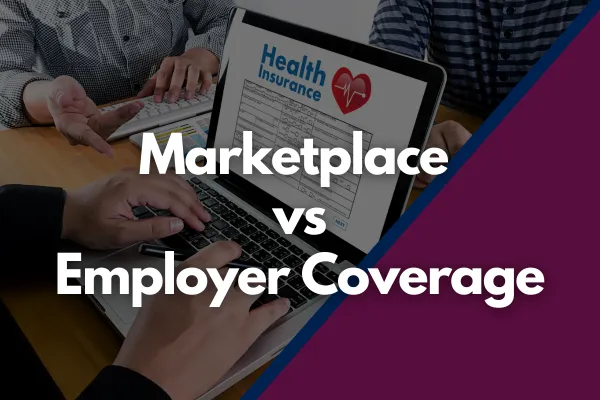
Marketplace vs. Employer Coverage: When Should You Make the Switch?
Marketplace vs. Employer Coverage:
When Should You Make the Switch?
For many people, getting health insurance through work feels like the default choice. But here’s the truth: employer-sponsored health insurance isn't always the best deal—especially when premiums are high, deductibles are steep, or coverage is limited.
If you’ve ever looked at your paycheck and thought, "Is this insurance even worth it?" — you’re not alone. And you may have options.
In this guide, we’ll break down the differences between Marketplace vs. employer coverage, and help you figure out if switching to a Marketplace (ACA) plan could save you money and give you better coverage.
🏢 What Is Employer Coverage?
Employer-sponsored insurance is health coverage offered by your job. In most cases, employers cover part of the premium, while employees pay the rest through payroll deductions.
Pros:
✔️ Often includes dental/vision add-ons
✔️ Premiums may be lower for large companies
✔️ Convenient enrollment during hiring
Cons:
❌ Limited plan choices
❌ High costs for family members
❌ Can’t shop around unless you lose your job
🏥 What Is Marketplace Coverage (ACA)?
Marketplace insurance—also known as ACA or Obamacare plans—is available through HealthCare.gov or your state’s exchange. It’s designed for individuals and families who don’t have access to affordable job-based insurance.
These plans are categorized by metal tiers (Bronze, Silver, Gold, Platinum) and offer Premium Tax Credits and Cost-Sharing Reductions for those who qualify.
Pros:
✔️ Access to subsidies (lower premiums & out-of-pocket costs)
✔️ Broader plan comparison and provider options
✔️ Ideal for freelancers, self-employed, or those with costly employer plans
Cons:
❌ No employer contribution
❌ Must enroll during Open Enrollment or a Special Enrollment Period
🔍 When Should You Consider Switching to a Marketplace Plan?
Let’s talk strategy. There are a few scenarios where Marketplace insurance might be the better option.
1️⃣ Your Employer Premiums Are Too High
If your portion of the premium (especially for family coverage) eats up your paycheck, a Marketplace plan with subsidies could cost significantly less.
💡 Example:
A family of four with a household income of $60,000 may qualify for a Silver plan with subsidies that costs under $300/month, compared to $900/month for employer coverage.
2️⃣ Your Job Doesn’t Offer Health Insurance
You’re not required to go uninsured just because your employer doesn’t offer coverage. Marketplace plans are designed for people in this exact situation.
3️⃣ You’re Only Covering Yourself at Work, But Need Family Coverage
Employer plans often charge high premiums to add a spouse or children. In this case, it might make sense to stay on your employer plan but get Marketplace coverage for your family.
4️⃣ You're Between Jobs or Working Part-Time
Marketplace coverage is ideal when you’re in transition or working freelance/gig jobs. You don’t need a job to qualify—and you might get free or low-cost coverage based on income.
5️⃣ You Don't Like Your Employer’s Plan Options
If your job only offers one limited plan with a narrow provider network, you may find more freedom and better doctors through the Marketplace.
💸 What About Subsidies?
This is where Marketplace plans really shine. Based on your income and household size, you could qualify for:
Premium Tax Credits to lower your monthly payments
Cost-Sharing Reductions (CSRs) to reduce deductibles, copays, and out-of-pocket maxes (available with Silver plans only)
➡️ Even if your income is moderate, you may still qualify thanks to expanded eligibility under recent ACA updates.
Important: If your employer offers affordable coverage (as defined by ACA standards), you may not qualify for subsidies—even if the coverage doesn’t work well for your needs.
📊 Quick Comparison: Marketplace vs Employer Coverage
Feature
Employer Coverage
Marketplace (ACA)
Plan Options
Usually 1–2
Dozens to compare
Subsidies Available?
No
Yes, based on income
Network Flexibility
Often limited
Wider networks available
Family Coverage Costs
Often expensive
May be cheaper with subsidies
Eligibility
Based on job
Open to anyone
Best For
Stable employment
Freelancers, families, part-timers, or high-cost employer plans
📝 How to Make the Switch (If It Makes Sense)
If you decide to leave your employer’s plan, timing is everything.
You can switch to a Marketplace plan:
During Open Enrollment (Nov 1, 2024 – Jan 15, 2025)
During a Special Enrollment Period (SEP) if you lose job-based coverage, get married, move, or have a baby
👉 Start by visiting HealthSherpa to compare plans and check your subsidy eligibility. Or reach out to a licensed agent to help you through the process.
🗣️ Final Thoughts: Employer Plan Not Working for You? You’ve Got Options.
Just because your job offers insurance doesn’t mean it’s the best fit—especially if it’s expensive, restrictive, or doesn’t cover your whole family.
A Marketplace plan might be more affordable, more flexible, and better suited to your situation—especially if you qualify for subsidies.
At Pereyda Financial, we help you compare plans side-by-side and walk you through your eligibility for tax credits, family plans, and enrollment timing.
📞 Reach out today for a free consultation (915) 265-5387, and let’s find out if switching makes sense for you.